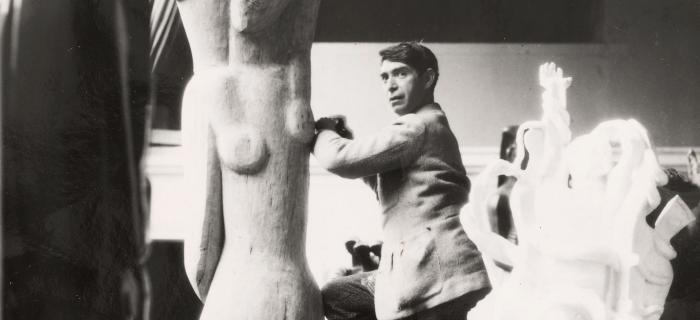DÉCOUVREZ LES 14 MUSÉES DE LA VILLE DE PARIS
Main menu

A sculptor recognised from the 1920s for his practice of direct carving, of wood (Samson and Delilah, the Prophet) and of stone (Woman with a Mandolin, Motherhood), Zadkine subscribed to the early 20th century primitivist trend and search for the avant-garde. “I think that the sculptors of my generation such as Gaudier-Brzeska, Villon, Archipenko, Brancusi, Lipschitz and myself can be considered as upholders of the ancient tradition of those stone and wood sculptors, who having left the forest, gave free rein to their dreams of fantastical birds and large tree trunks." After a short Cubist interlude devoted to the geometrisation of forms (Woman with a Fan, Accordion Player), he then headed towards a reinterpretation of Antiquity as demonstrated by his interest in the 1930s for mythological themes (Rebecca, Niobe) and the groups sculpted in bronze (The Birth of Venus). In 1938, he took on four projects for monuments to poets, Apollinaire, Jarry, Lautréamont and Rimbaud. After the war and the Monument to the Destroyed City, the figure emblematic of human pain erected in the port of Rotterdam in 1953, his work developed in the direction of Baroque expressionism. “Emotion! Humanity! …The object created by the sculpture must arouse emotion in the onlooker". In this respect, Zadkine is considered a pioneer of the introduction of modern art into public spaces. The fusion of the human and the vegetal became one of his preferred themes, giving rise to monumental works such as Orpheus and the Human Forest. In 1955, Zadkine produced several studies for the order for a Monument to Van Gogh which was to be erected in Auvers in 1961, other monuments being created for Wasmes, Zundert and St Rémy de Provence.
Although the human figure had always been at the centre of his work, in his last sculptures designed for architectural purposes, Zadkine set off at the end of his life down a new route devoted to abstract forms, networks of arabesques and interlacing. The annotated catalogue of Zadkine's sculpted work listed 593 sculptures. They were divided between wood (131), stone and marble (112), clay (132), plasters and bronzes.